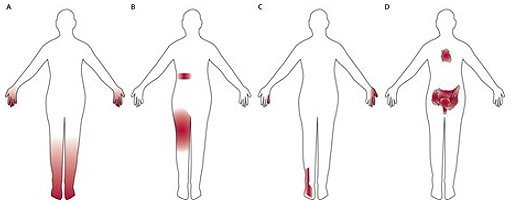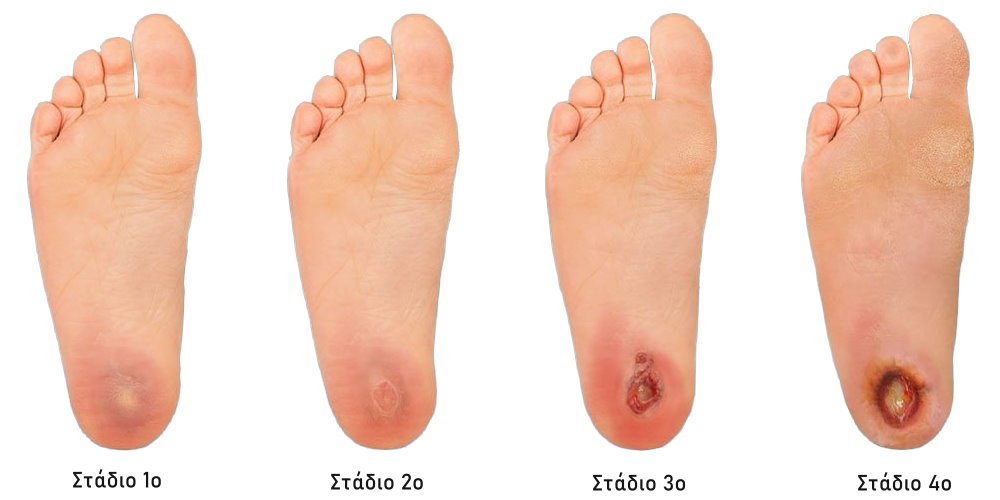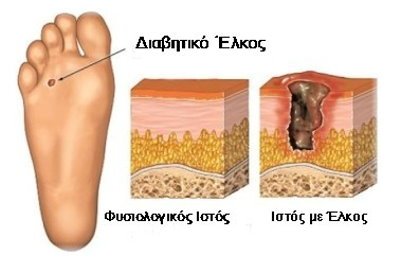Diabetes is a disorder in which the body has difficulty controlling blood glucose levels. Glucose is the product of the carbohydrate metabolism of food and is used by all cells in the body to produce energy. Normally, the hormone insulin is produced by the pancreas, regulates blood glucose levels and helps cells convert glucose into energy. Its lack results in "opening the doors" of the cells allowing glucose to enter the blood while at the same time the cells do not have enough energy. Over time, high glucose levels cause damage to the body. The causes are complex, but this increase occurs in part due to obesity and lack of physical activity.
All types of diabetes can lead to complications and increase the risk of premature death. There are 3 types of diabetes, type 1 diabetes (MD1), type 2 diabetes (MDD2), and gestational diabetes (MDD). Type 1 is characterized by the absence of insulin production, while type 2 is characterized by insufficient use of insulin by the body. Although type 2 diabetes is potentially avoidable, the causes of type 1 diabetes remain unknown and there is no way to prevent it. Gestational diabetes is characterized by hyperglycemia at levels that are below those needed to be diagnosed with diabetes during pregnancy.

Type 1 diabetes is a disease that usually occurs in childhood or adolescence and has an autoimmune etiology, ie the immune system itself destroys the cells that produce insulin in the pancreas (β-cells). The chances of developing type 1 diabetes are influenced by both genetic and environmental factors while increasing due to heredity. Its development is usually gradual and shows no symptoms. The immune reaction can occur spontaneously or occur after an exogenous cause such as an infection or a virus. In patients with type 1 diabetes, glucose is not delivered to the cells because no insulin is available. When glucose accumulates in the blood instead of being transferred to the cells, the cells of the body do not have the necessary nutrients and so other systems of the body have to provide energy in order to perform important bodily functions. As a result, there is a large amount of glucose in the blood, which can cause:
- Dehydration: In an effort to rid the body of excess glucose, the result is frequent urination. When the kidneys lose glucose due to urination, a large amount of water is also lost, leading to dehydration.
- Weight Loss: The loss of glucose found in the urine also means the loss of calories that provide energy. Thus, many people with diabetes lose weight. Dehydration also contributes to weight loss.
- Diabetic ketoacidosis: Without insulin and due to the lack of energy of the cells, the body breaks down fat cells. Products of this breakdown of fat are organic compounds called ketones, which are used to produce energy. Levels of these substances gradually accumulate in the blood, causing increased acidity. The liver continues to release the glucose it stores in order to aid the process. As the body is unable to utilize glucose without the presence of insulin, even more glucose accumulates in the blood. The combination of high glucose, dehydration and accumulated acids is called ketoacidosis and can be extremely dangerous to health if not treated immediately.
- Injuries to the body: Over time, high blood glucose levels can damage the nervous system and the tiny blood vessels in the eyes, kidneys, and heart, predisposing a person to atherosclerosis of the arteries, which can lead to a heart attack or stroke. episode.
Symptoms:
- Intense thirst
- Increased appetite
- Dry mouth
- Nausea and occasional vomiting
- Abdominal pain
- Frequent urination
- Unexplained weight loss
- Fatigue and weakness
- Blurred vision Heavy breathing
- Common infections of the skin, urinary tract or genitals
The most worrying of these are:
- Shivering and confusion
- Tachypnea
- Bad breath
- Stomachache
- Loss of consciousness (rare)
Type 2 diabetes is a chronic disease that occurs when the pancreas does not produce the required amount of insulin or when cells stop responding to insulin. The result is an increase in blood glucose levels and is associated with obesity.
Type 2 diabetes affects 90-95% of the total Diabetic population worldwide and is often referred to as "Adult Diabetes", because it affects people with insulin resistance but also with a relative deficiency. So because these people do not completely lack insulin, they just do not get as much as they need, many of them may never need insulin therapy and others may be very late. Many patients with type 2 diabetes have comorbid conditions, such as heart disease and hypertension or dyslipidemia (abnormal types or lipid levels, such as high triglycerides, low HDL cholesterol, and elevated LDL cholesterol).
Type 2 diabetes manifests itself with excessive thirst and unexplained fatigue. The symptoms do not differ from those of type 1 diabetes but are not so acute, with the result that the diagnosis occurs much later than their onset. The most worrying of these are:
- Incisions and bruises that take a long time to heal
- Numbness in the hands or feet
- Blurred vision
- Fatigue Dry and itchy skin (itching)
- Recurrent or common infections, such as skin, gum and bladder infections
- Irritability Increased thirst, hunger and urination
This condition puts patients' blood vessels and vital organs at risk. Without proper treatment, diabetes can increase the risk of heart disease, stroke, kidney disease and sexual dysfunction.
- Heart deseases
Diabetics are up to five times more likely to develop heart disease or stroke. Prolonged inadequate control of blood glucose levels increases the risk of atherosclerosis, in which lipids settle on the walls of large and medium-sized arteries. These lipids (mainly the "bad" LDL cholesterol) that circulate in the blood, over time begin to erode the walls of arteries, form atherosclerotic plaques and gradually the arteries lose their elasticity and decrease in diameter. This can lead to poor blood supply to the heart, causing angina and increasing the risk of heart attack and stroke.
- Nerve damage
Excess blood glucose can damage blood vessels in the nerves. This is why tingling and numbness are caused in patients' hands and feet. When diabetes affects the nerves in the digestive system, symptoms include nausea, vomiting, diarrhea and constipation.
- Kidney disease
About 40% of patients with diabetes develop kidney disease. Diabetes is an endocrine disorder in which the tissues are unable to absorb and use glucose (sugar) for energy. Thus, glucose accumulates in the blood, causing damage to blood vessels (small and large) and tissues throughout the body and leading to a number of complications, such as blindness, gangrene and kidney failure that require dialysis. Kidney complications usually occur after the first 10-15 years of diabetes. That is why even those who know they have diabetes usually ignore the risk and do not treat it in time. However, kidney damage, like other complications, progresses slowly and steadily. Factors that lead to kidney disease are inadequate blood sugar regulation, with glycosylated hemoglobin levels, high blood pressure, smoking, obesity and genetic predisposition.
- Diabetic foot
This term describes the damage that can occur in the leg of a diabetic as a result of peripheral neuropathy or peripheral arterial disease, in combination with an unnoticed leg injury. The patient with peripheral neuropathy may not feel the painful stimuli. Thus, a repeated minor injury, eg from a narrow shoe, can create a very large and deep wound (ulcer).Such a wound, especially in patients who have poor circulation due to arterial disease, can persist for many months, become infected or even cause osteomyelitis (infection of the bone below). The treatment of these ulcers requires first of all "discharge" (virtually no pressure on the area at all), regular local treatment, regular surgical cleaning by the specialist and, as the case may be, the use of antibiotics. Unfortunately, the outcome is not always good and amputation can not always be avoided.
- Sexual dysfunction
People with diabetes are more likely to have erectile dysfunction. It is usually treated with medication, but patients who smoke and have already developed damage to nerves and blood vessels are at greater risk. Women with diabetes may experience decreased sexual desire, less pleasure from intercourse, vaginal dryness, lack of orgasm and pain during sex.
Gestational diabetes It is a distinct type of diabetes that occurs only during pregnancy. It is due to the increased secretion of hormones from the placenta, which prevent insulin from transporting glucose into the cells, resulting in more and more glucose accumulating in the blood. In most cases, blood sugar levels can be regulated with careful diet and exercise. However, some women will need more intensive insulin treatment. Usually, gestational diabetes goes away by the end of the pregnancy, but that does not mean they have said goodbye to diabetes forever. They and their children are at increased risk of developing type 2 diabetes in the future.
The risk factors for developing diabetes are:
- Family history
- Obesity
- The age of the mother
- Sedentary life
- Polycystic ovary syndrome
When a pregnant woman is diagnosed with gestational diabetes, both she and the fetus are more prone to various complications. Initially, the possibility of other pregnancy complications increases, such as preeclampsia, but also the possibility of premature birth.

People with diabetes can live a healthier life if their blood sugar levels are under control and well managed. Valid diagnosis and intervention is the key to living well with diabetes. There are several ways to control diabetes through diet, daily walking and proper medication. Nevertheless, diabetes is the leading cause of blindness, kidney disease and amputation.
Complications can include nerve damage and poor blood circulation. These problems make the feet vulnerable to skin wounds (ulcers) that can get worse quickly. Proper management and daily care of the feet can help prevent foot ulcers.
- Check your feet daily. Check your feet once a day for blisters, cuts, cracks, ulcers, redness, tenderness or swelling. Use a hand mirror to look at the soles of your feet or ask someone else for help.
- Wash your feet daily with lukewarm, not hot, water and mild soap. Strong soaps can damage the skin. Dry them gently, especially between the fingers.
- Keep the skin dry, especially between the fingers. Use a moisturizing lotion or cream on the back and soles of your feet to keep the skin soft. Preventing dry skin cracking helps prevent bacteria from entering. Do not put lotion, oil or cream between your toes.
- Do not remove calluses or other foot injuries yourself. Consult your doctor to remove any of these injuries.
- Cut your nails carefully and straight. Curved nails are more likely to penetrate the skin.
- Do not walk barefoot even indoors to avoid foot injuries.
- Wear clean, dry fiber socks daily to keep sweat away from your skin, such as cotton fibers, not nylon. Avoid socks with tight tires that reduce circulation or socks with seams that can irritate the skin.
- Buy shoes that fit your foot perfectly. Prefer to buy diabetic shoes, which have a light construction, soft leather, without inner seams to avoid friction with the leather, rigid sole where it reduces high pressures and evenly distributes them all over the sole and the inner sole is made of soft material. For best results, individual footwear and soles can be made by footprint for each type of foot, even with discharge points for ulcers.The orthotics are special inserts of the shoes, which offer transverse and metatarsal support, isomeric and harmonious distribution of pressure in the sole, have a soft effect and absorption of vibrations. They help to restore the natural position of the foot. They compensate for deformities and abnormalities of the foot and relieve pain, correcting posture.
- Do not smoke. Smoking worsens circulation and reduces the amount of oxygen in the blood. These traffic problems can make the injuries more serious and the scars poorer. Talk to your doctor if you need help to quit smoking.
- Schedule regular foot checks. Your doctor may inspect your feet for early signs of nerve damage, circulation problems or other foot problems. Schedule foot tests at least once a year or more often as recommended by your doctor.
Contact your doctor immediately if you have any of the following symptoms:
- Edema
- Redness
- Blisters
- Ulcer or bleeding
- Increased heat or cold
- Increased pain
- Discoloration of the skin
- Unpleasant smell Fever or chills
- Edema
- Feeling of tingling

If you have an ulcer, follow your healthcare provider's instructions for treating it. Strictly follow the instructions on how to take care of your feet to prevent the formation of new ulcers in the future.
In addition to your primary care physician, you could seek the advice of an endocrinologist, with special training in the treatment of diabetes and other hormonal disorders, or a dietitian.



